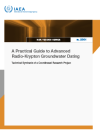Groundwater is the largest source of freshwater for mankind. Isotope techniques are used to determine the origin and replenishment rates of groundwater, obtained through the use of stable and radioisotopes naturally present in groundwater.
Groundwater
Groundwater constitutes 30 per cent of the world’s available freshwater. A further 69 per cent is locked up in polar icecaps, while rivers and lakes only represent one per cent. Groundwater is often hidden deep in aquifers, permeable rocks and sediments and is extracted using pumping wells. Often, aquifers can be renewable water resources, slowly replenished by rainfall infiltration over hundreds up to many thousands of years.
A growing global population, coupled with more intensive agriculture and increasing industrial use, have led to an ever-rising demand for groundwater. Water managers in many regions have had to deal with an over-exploitation of accessible aquifers and are often forced to rely on deep ancient groundwater sources for reliable freshwater supplies. Added to this are threats emanating from the spill of contaminants and toxins into the groundwater, for instance from agriculture, industry or urban activities.
A scientific assessment of the origin and replenishment rate of aquifers is critical in fulfilling their function as reliable long-term water supplies. Stable and radioisotopes naturally present in groundwater can be used to learn more about the origin and replenishment rates of groundwater. The isotopes of water (hydrogen, oxygen) and radioisotopes (tritium), dissolved carbon (carbon-14) and noble gases (helium-3, helium-4 and krypton-81) are used to estimate groundwater ages.
Dealing with pollution in groundwater is more complex as aquifer contamination is extremely difficult to remediate. Stable and radioisotope tracers (nitrogen-15, carbon-13 and tritium) are used to help fingerprint the sources of contaminants and to quantify the transformations and biodegradation of pollutants in aquifer systems.






